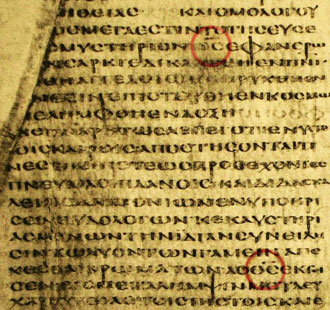 HOME HOME  ARTICLES ARTICLES  BIBLES BIBLES  LINKS LINKS  HERETIC HERETIC
 1 Timothy 3:16 ~ A Corruption of Scripture? 1 Timothy 3:16 ~ A Corruption of Scripture?
Christian interpolation
Christian interpolation refers to the alleged modifications made by Christian writers that could distort historical texts about Yahshua, as well as later additions or alterations to original scriptural writings that introduce Christian themes or doctrines. This concept highlights concerns about the authenticity of the original accounts and the influence of Christian beliefs on historical documentation. Understanding Christian interpolation is essential for analyzing the integrity of religious texts and their interpretations throughout history.
Synonyms: Addition, Insertion, Alteration, Modification, Amendment.
King James Version 1Timothy 3:16
And without controversy great is the mystery of godliness:
God was manifest in the flesh,
justified in the Spirit, seen of angels, preached unto the Gentiles,
believed on in the world, received up into glory.
In 1 Timothy 3:16, some textual variations exist, particularly concerning the pronoun "he" and the word "God".
Some manuscripts read "he who" or "he," while others have "God." These differences have led to debates about the deity of Christ and interpretations of the verse, particularly in relation to the Trinity and the incarnation. Modern translations generally favor the reading "he who," but the King James Version and others use "God".
Interpretation
The reading of "God" in the text supports the Trinitarian view of Christ's divinity,
~ while the reading "he who" or "he" is seen as referring to Christ (Yahshua) specifically.
Textual Variants
1 Timothy 3:16 speaks about the mystery of godliness and how God was manifested in the flesh.
The Greek word "theos" (God) appears in some manuscripts,
while others have "hos" or "ho," meaning "he who" or "he".
Modern Translations
Many modern translations have adopted the reading "he who" or "he" to align with the earlier and more reliable manuscripts.

God manifested in the flesh
"God manifested in the flesh" (Greek: θεός ἐφανερώθη ἐν σαρκί, theos ephanerōthē en sarki) is a textual variant found in 1 Timothy 3:16 in later Greek manuscripts of the New Testament. It likely originated in the 3rd century, either as a scribal error influenced by orthographic conventions or as an intentional theological clarification to emphasize Christ's divinity. This reading was incorporated into the Textus Receptus in the 16th century and became a standard in many New Testament editions for centuries.
From the 18th century onward, this variant became the subject of dogmatic disputes. Textual critics questioned its authenticity, risking accusations of supporting Unitarianism. However, since the late 19th century, the variant "who was manifested in the flesh" (ὅς ἐφανερώθη ἐν σαρκί, hos ephanerōthē en sarki), supported by earlier manuscripts and translations, has been considered authentic. The defense of the variant regarded as affirming Christ's divinity, however, continues to be carried out by supporters of the Textus Receptus.
Antiquity and early Middle Ages
The Codex Sinaiticus (4th century), the oldest Greek manuscript of the New Testament containing the text of 1 Timothy, preserves the variant ὅς (hos, "who"), giving the phrase in 1 Timothy 3:16 the meaning "who was manifested in the flesh". This reading is supported by the 5th-century manuscripts Codex Alexandrinus, Codex Ephraemi Rescriptus, as well as later manuscripts such as Codex Augiensis, Codex Boernerianus, and others (e.g., Minuscules 17, 33, 365, 442, 1175, 2127, and the lectionary 599). It is also affirmed by ancient translations, including the Syriac, Gothic, Ethiopian, and Coptic versions. Church Fathers such as Origen, Epiphanius of Salamis, Jerome, Theodoret, Cyril of Alexandria, and Liberatus of Carthage used this variant.
The Codex Claromontanus transmits the variant ὅ (ho, "which"), relating it to μυστηριον (mystērion, "mystery") from the preceding phrase. The resulting meaning is "great is the mystery of godliness, which was manifested in the flesh". This variant is supported by Old Latin translations, the Vulgate, and Latin Church Fathers such as Ambrose, Pelagius, and Augustine of Hippo. This reading indirectly supports ὅς as the original variant, as it likely arose from an intentional alteration for grammatical consistency, disregarding the context that points clearly to Christ. This reading is characteristic of the Western text-type.
The Peshitta uses a relative pronoun (d-) that can correspond to either ὅς (hos) or ὅ (ho) in Greek.
Uncial 061 contains the variant ὥ (hō "to whom"), rendering the phrase "to whom was manifested in the flesh".
The ὅς variant is widely regarded as original, based on its attestation in early manuscripts and translations.
Scholars of Christological hymns note that early confessions of faith often begin with a relative pronoun, as seen in Philippians 2:6 and Colossians 1:15.
θεός variant
One of the oldest Greek manuscripts using the variant θεός ἐφανερώθη (theos ephanerōthē, "God was manifested") is the Codex Athous Lavrensis, dated to the late 9th or early 10th century.This variant is supported by most later manuscripts. Important examples include the Codex Mosquensis I, Codex Angelicus. Codex Porphyrianus, Uncial 075, Uncial 0150, and others such as Minuscules 6, 81, 104, 181, 326, 330, 436, 451, 614, 629, 630, 1241, 1505, 1739, 1877, 1881, 1962, 1984, 1985, 2492, 2495, Byzantine text-type manuscripts, and lectionaries.
Among the Church Fathers, this variant appears from the 4th century onwards, used by figures such as Gregory of Nyssa, Didymus the Blind, John Chrysostom, Theodoret, Euthalius, and later theologians.
The Codex Sinaiticus was corrected by a 12th-century scribe (corrector e). Similarly, corrections aligning the texts of the Codex Alexandrinus, Ephraemi Rescriptus, and the Codex Clermont with the normative theological text were carried out in other manuscripts. These adjustments emphasized the doctrine of divine incarnation.
The variant θεός ἐφανερώθη could have arisen accidentally if ΟΣ was misread as the nomina sacra ΘΣ (an abbreviation for θεός). Alternatively, it may have been a deliberate modification to provide a noun for the six subsequent verbs, motivated by orthographic considerations. According to Bruce M. Metzger, there is also a slight possibility that the change was dogmatically inspired.
Bart D. Ehrman argues that the variant likely originated no later than the 3rd century,
with anti-adoptionist motivations aimed at emphasizing Christ's divinity. ~ Wikipedia.

Printed Text
The variant "God manifested" was adopted in the first printed editions of the Greek New Testament (Textus Receptus) and, through them, entered modern translations of the New Testament. Ludolf Küster, in his second and expanded edition of John Mill's Novum Testamentum, used the variant consistent with the Textus Receptus but noted in a footnote the manuscripts and Church Fathers supporting the variant ὅς ἐφανερώθη.
Isaac Newton wrote An Historical Account of Two Notable Corruptions of Scripture, rejecting two Textus Receptus variants: the Johannine Comma and θεός ἐφανερώθη from 1 Timothy 3:16. Newton, fearing accusations of unitarianism, refrained from publishing his work, instead sending the manuscript to John Locke in 1690.
Johann Jakob Wettstein, a theologian from Basel, observed during his study of the Codex Alexandrinus that the ligature above the letters theta and sigma was added with different ink and by another hand. Additionally, the horizontal line inside theta was not part of the letter but a bleed-through from the other side of the parchment. Thus, Christ was not called God in this manuscript. In 1730, Wettstein published Prolegomena ad Novi Testamenti Graeci, supporting the variant ὅς ἐφανερώθη and questioning the authenticity of the Johannine Comma and Acts 20:28. He derived this variant from the Codex Alexandrinus and Codex Ephraemi Rescriptus. Shortly after the publication of Prolegomena, he was accused of Socinianism, expelled from the clergy, and relocated to Amsterdam. There, between 1751 and 1752, he published his version of the New Testament text.
Supporters of the Textus Receptus included Daniel Whitby, Franz Anton Knittel, and others. Carl Gottfried Woide, in his facsimile of the Codex Alexandrinus, used the variant ΘΣ and disputed Wettstein's claim that the original text had ΟΣ.
Critics of the Textus Receptus, such as Johann Albrecht Bengel, Johann Jakob Griesbach, Karl Lachmann, Constantin von Tischendorf, Samuel Prideaux Tregelles, and John Wordsworth, rejected the variant ΘΣ.
Today, fundamentalist Protestants in the Burgon Society and the King James Only movement defend the Textus Receptus variant. They claim that the critical apparatus of modern editions of the Greek New Testament has been falsified, asserting that the corrector of the Codex Sinaiticus lived not in the 12th century but in the 4th century, with corrections made before the manuscript left the scriptorium. They also argue that alleged falsifications by modern textual critics extend to manuscripts A, C, F, and G. Proponents maintain that the Textus Receptus variant is grammatically superior and that this verse is one of the few biblical texts directly supporting Christ's divinity, with other verses doing so only indirectly. ~ Wikipedia.
Interlinear Scripture Analyzer

 The Companion Bible, E.W.Bullinger - 1 Timothy 3:16 The Companion Bible, E.W.Bullinger - 1 Timothy 3:16
God. The Revised Version prints "He Who", and adds in margin, "Theos (God) rests on no sufficient evidence". The probability is that the original rending was ho (which), with the Syric and all the Latin Versions, to agree withmusterion (neut.) The Greek uncial being O, some scribe added the letter s, making OC (He Who), which ho thought made better sense. Later another put a ark in this O, making the word OC, the contraction for OEOC, God. This mark in Codex A, in the British Museum, is said by some to be in different ink.
 Vincent's Word Studies of the New Testament - 1 Timothy 3:16 Vincent's Word Studies of the New Testament - 1 Timothy 3:16
God (Θεὸς)
But the correct reading is ὃς who. The antecedent of this relative is not mystery, as if Christ were styled “the mystery,” but the relative refers to Christ as an antecedent; and the abruptness of its introduction may be explained by the fact that it and the words which follow were probably taken from an ancient credal hymn. In the earlier Christian ages it was not unusual to employ verse or rhythm for theological teaching or statement. The heretics propounded their peculiar doctrines in psalms. Clement of Alexandria wrote a hymn in honor of Christ for the use of catechumens, and Arius embodied his heresy in his Thalia, which was sung in the streets and taverns of Alexandria. The Muratorian Canon was probably composed in verse. In the last quarter of the fourth century, there are two metrical lists of Scripture by Amphilochius and Gregory Nazianzen.
Hebraic Roots Bible 1Timothy 3:16
Truly, great is the divine mystery of righteousness:
which was revealed in the flesh, was justified in the Spirit,
was seen by cherubs, was proclaimed among nations,
was believed on in the world, was taken up in glory.
Return to top 
 HOME HOME  ARTICLES ARTICLES  BIBLES BIBLES  LINKS LINKS  HERETIC HERETIC
|


|





